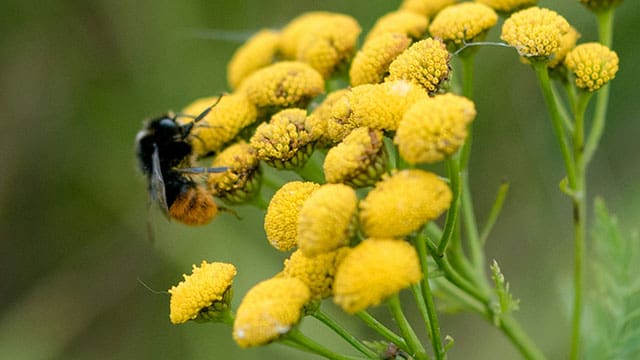Understanding the feeding habits of Varroa mites may provide clues to combating a major threat to honeybees
A recent study by researchers at the University of Alberta sheds new light on combating the Varroa mite, a major threat to honeybee populations in Canada. The Varroa mite, also known as Varroa destructor, is responsible for significant annual losses of 30 to 40 percent of bee colonies across the country.
The effectiveness of controlling the mite hinges on understanding its feeding habits throughout the bee’s lifespan. Traditionally, it was believed that the Varroa mite fed on the bee’s hemolymph or blood during its development. However, groundbreaking research published in 2019 by the National Academy of Science revealed that the mite actually feeds on a layer of fat beneath the bee’s exoskeleton, leading to a paradigm shift in our understanding of the parasite.

Olav Rueppell
 Photo courtesy Sandra Seitamaa |
| Related Stories |
| Four tips for a bee-friendly yard
|
| Exploring bee behaviour opens new career possibilities
|
| The nasty ways insects inflict damage on humans
|
Building upon this discovery, Olav Rueppell from the Department of Biological Sciences at the University of Alberta, along with collaborators from the Chinese Academy of Agricultural Sciences in Beijing, conducted further research on Varroa mite behaviour during the pupal stage inside the hive’s wax cells.
Their study, published in January in Nature Communications, confirmed that the Varroa mite feeds on hemolymph during this stage of the bee’s life. Understanding this interaction is crucial for developing effective control measures to combat the pest.
Rueppell emphasizes the importance of comprehending the basic biology of the honeybee-mite interaction, particularly given their close relationship as arthropods. Efforts are underway to develop pesticides and enhance bees’ natural defences against Varroa mites and other honeybee pests.
Existing pesticides, such as amitraz, coumaphos, and fluvalinate, are becoming less effective due to the mite’s evolving resistance. Rueppell stresses the need to find alternative methods to support bee health, as honeybees play a critical role in pollinating food crops, including canola, with the Canadian industry valued at over $3 billion annually.
Despite efforts to combat Varroa mites, another potential threat looms on the horizon – the Tropilaelaps mite. While not yet present in Canada, researchers are concerned about its potential impact on honeybee populations.
With Alberta alone housing 40 percent of Canada’s honeybee colonies, the urgency to address the Varroa mite threat is clear. While honeybees are not endangered, the beekeeping industry faces significant challenges from pests and other stressors, highlighting the importance of ongoing research and intervention efforts.
| Staff
The opinions expressed by our columnists and contributors are theirs alone and do not inherently or expressly reflect the views of our publication.
© Troy Media
Troy Media is an editorial content provider to media outlets and its own hosted community news outlets across Canada.

